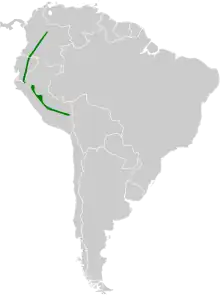Black-billed treehunter
The black-billed treehunter (Thripadectes melanorhynchus) is a species of bird in the Furnariinae subfamily of the ovenbird family Furnariidae. It is found in Colombia, Ecuador, and Peru.[2]
| Black-billed treehunter | |
|---|---|
 | |
| Thripadectes melanorhynchus - Black-billed Treehunter (Song) | |
| Scientific classification | |
| Domain: | Eukaryota |
| Kingdom: | Animalia |
| Phylum: | Chordata |
| Clade: | Dinosauria |
| Class: | Aves |
| Order: | Passeriformes |
| Family: | Furnariidae |
| Genus: | Thripadectes |
| Species: | T. melanorhynchus |
| Binomial name | |
| Thripadectes melanorhynchus (Tschudi, 1844) | |
 | |
Taxonomy and systematics
The black-billed treehunter has two subspecies, the nominate T. m. melanorhynchus (Tschudi, 1844) and T. m. striaticeps (Sclater & Salvin, 1875).[2] It and the streak-breasted treehunter (T. rufobrunneus) are sister species.[3][4]
Description
The black-billed treehunter is 20 to 20.5 cm (7.9 to 8.1 in) long and weighs 39 to 46 g (1.4 to 1.6 oz). It is a bulky, dark furnariid with a thrush-like shape. The sexes have the same plumage. Adults of the nominate subspecies have a mostly blackish-brown face with well-defined buff streaks and lores that are grizzled blackish brown and buff. Their crown is blackish brown with narrow buff streaks. Their back is dark brown with buff streaks and their rump dull dark brown that blends to reddish brown uppertail coverts. Their wings are rich dark brown and their tail dark chestnut-brown. Their throat is ochraceous with dark feather borders that give a scaly appearance. Their breast is rufescent-brown with faint pale streaks, their belly a mostly plain duller rufescent brown, and their flanks and undertail coverts darker rufescent-brown. Their iris is brown to dark brown, their bill black, and their legs and feet dark blackish gray to brown. Juveniles have less distinct streaking on the back and throat than adults. Subspecies T. m. striaticeps has a paler (less sooty) crown and back than the nominate, with wider streaks on the back and more rufescent wings.[5][6][7]
Distribution and habitat
The nominate subspecies of the black-billed treehunter has the larger range. It is found on the east slope of the Andes from Sucumbíos Province in northern Ecuador south all the way through Peru to the Department of Puno. Subspecies T. m. striaticeps is found on the eastern slope of Colombia's Eastern Andes south from Boyacá and Casanare departments to near or into northern Ecuador. The species primarily inhabits montane evergreen forest and also occurs in secondary forest and in stunted forest along ridgetops. In elevation it ranges between 1,000 and 1,800 m (3,300 and 5,900 ft) in Colombia and 1,000 and 1,700 m (3,300 and 5,600 ft) in Ecuador and Peru.[5][6][7]
Behavior
Movement
The black-billed treehunter is a year-round resident throughout its range.[5]
Feeding
The black-billed treehunter's diet is mostly arthropods and may also include small vertebrates. It forages in dense undergrowth, usually by itself, and rarely joins mixed-species feeding flocks. It gleans its prey but the substrates from which it does so have not been fully defined.[5][6][7]
Breeding
The black-billed treehunter's breeding season has not been defined but spans at least from October to April. It is thought to be monogamous. It excavates a tunnel up to 1 m (3.5 ft) long in an earthen bank with a chamber at the end that it floors with leaf stems and sometimes thin sticks. The one known clutch was of three eggs. The incubation period and time to fledging are not known. Both parents provision nestlings.[5]
Status
The IUCN has assessed the black-billed treehunter as being of Least Concern. It has a large range, and though its population size is not known it is believed to be stable. No immediate threats have been identified.[1] It is considered uncommon to locally fairly common and occurs in several protected areas.[5]
References
- BirdLife International (2016). "Black-billed Treehunter Thripadectes melanorhynchus". IUCN Red List of Threatened Species. 2016: e.T22702896A93894291. doi:10.2305/IUCN.UK.2016-3.RLTS.T22702896A93894291.en. Retrieved 6 September 2023.
- Gill, Frank; Donsker, David; Rasmussen, Pamela, eds. (July 2023). "Ovenbirds, woodcreepers". IOC World Bird List. v 13.2. Retrieved July 31, 2023.
- Derryberry, E. P., S. Claramunt, G. Derryberry, R. T. Chesser, J. Cracraft, A. Aleixo, J. Pérez-Emán, J. V. Remsen, Jr., and R. T. Brumfield. (2011). Lineage diversification and morphological evolution in a large-scale continental radiation: the Neotropical ovenbirds and woodcreepers (Aves: Furnariidae). Evolution 65(10):2973–2986. https://doi.org/10.1111/j.1558-5646.2011.01374.x
- Claramunt, S., Derryberry, E.P., Cadena, C.D., Cuervo, A.M., Sanín, C. and Brumfield, R.T. (2013). Phylogeny and classification of Automolus foliage-gleaners and allies (Furnariidae). Condor 115(2): 375–385.
- Remsen, Jr., J. V. and E. de Juana (2020). Black-billed Treehunter (Thripadectes melanorhynchus), version 1.0. In Birds of the World (J. del Hoyo, A. Elliott, J. Sargatal, D. A. Christie, and E. de Juana, Editors). Cornell Lab of Ornithology, Ithaca, NY, USA. https://doi.org/10.2173/bow.blbtre1.01 retrieved September 6, 2023
- Ridgely, Robert S.; Greenfield, Paul J. (2001). The Birds of Ecuador: Field Guide. Vol. II. Ithaca: Cornell University Press. p. 373. ISBN 978-0-8014-8721-7.
- McMullan, Miles; Donegan, Thomas M.; Quevedo, Alonso (2010). Field Guide to the Birds of Colombia. Bogotá: Fundación ProAves. p. 122. ISBN 978-0-9827615-0-2.
